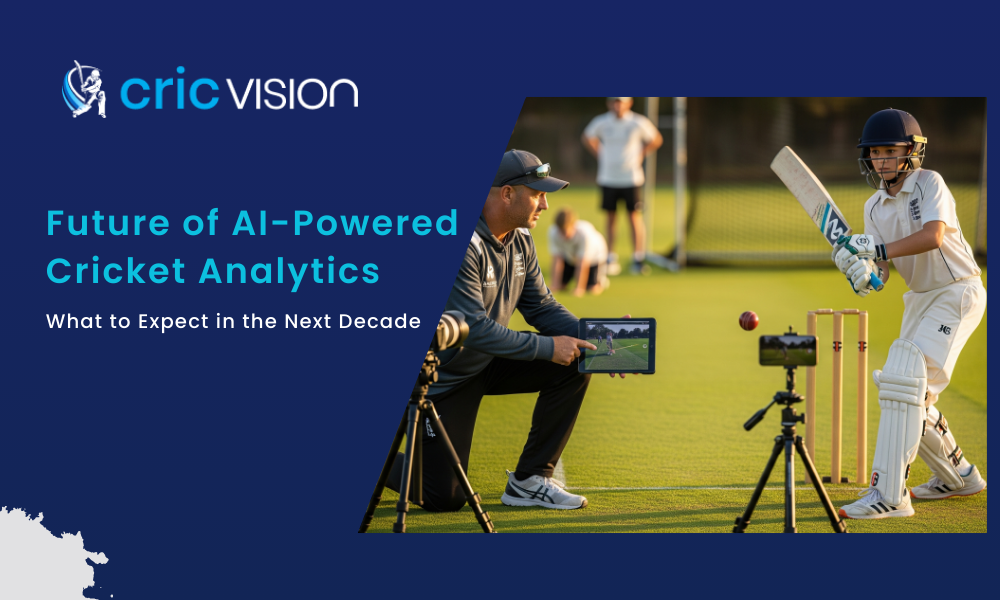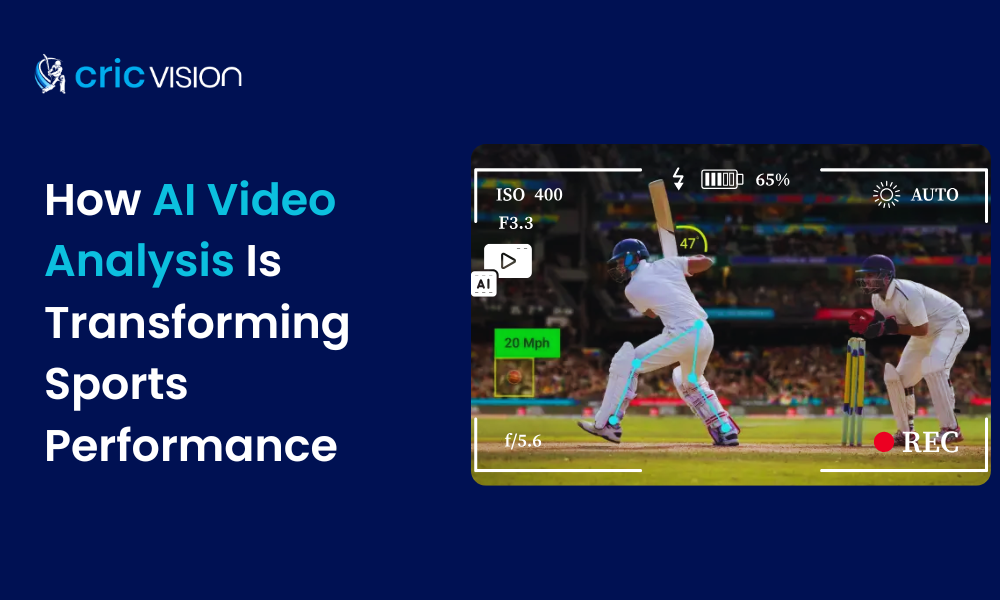Cricket has always been about numbers-runs, wickets, strike rates, and averages. But in the coming decade, these numbers will go beyond records and become smarter, faster, and more predictive. From real-time insights during matches to AI-powered forecasting of player performance, analytics will transform how fans, players, and teams experience the game. The future of Future of AI-Powered Cricket Analytics is not just about explaining what happened but predicting what’s likely to happen next.
The Rise of AI in Cricket Analytics
The next era of cricket analysis will move beyond static reports and post-match summaries. Predictive analytics, AI-driven performance tracking, and detailed player behavior insights will shape strategies on and off the field. Teams will rely on AI to detect patterns and make tactical calls, while fans will enjoy immersive experiences that make every match more engaging.
What is Driving the Evolution of Cricket Analytics?
The actual driving factor is technology. In each match, modern cricket produces thousands of data pieces, including ball speed, angles of the swings, movements of players and even crowd collision.
These real-time patterns are being cracked with the use of AI and machine learning. The use of high-speed cameras, wearables, and tracking sensors is providing bands with more ideas on insight into the performance of players.
Cricket has entered an era where intuition meets intelligence, and analytics bridges that gap. It is that combination of intuition and information that is defining the present game.
How Will AI Change Player Performance Analysis?
Training is already going smarter through AI. In place of an oversimplified fitness model, there is now an individualized model which targets players at places of weakness, such as a batter working against spin, or a bowl wearing out his arm following long seasons. Fatigue level monitoring through wearables works to avoid an injury when it happens.
The other innovation is virtual coaching. Under VR simulations, batters are able to confront bowlers who are to be faced in future series. It is like training on Mitchell Starcs yorkers or Rashid Khan googlies without going to the nets. Even the board in England has reported that data-driven training saw a 20 % drop in injuries.
Why is Predictive Analytics a Game-Changer?
There will always be the element of unpredictability in cricket and educational analytics is taking the guesswork away. Algorithms now compute win probabilities ball by ball, approximate how the dewing or pitching conditions will shift and point to major interplay between bowlers and batters.
These models were introduced by broadcasters to the World Cup of 2019 as percentages of the win are displayed on screen live. It was popular among the fans and teams began to rely on similar tools without comment and make decisions.
How Will Fans Experience Cricket Differently?
The analytics does not only belong to the coaches but it is also changing the future of the fan experience. Fantasy leagues already present a billion-dollar business and fantasy game performance depends greatly on the stats. Fans are taking data to create superior fantasy teams, forecast the outcomes and even argue consuming facts to their friends.
AR and VR will move it even further. Just take a headset and walk out onto a virtual field and see the game through the eyes of a batter. The last thing that the fans are doing is watching no more, the fans will participate. In fact, the fantasy cricket market alone is projected to hit USD 3.7 billion by 2030.
How Will Cricket AI Apps Shape the Future?
Applications are starting to mediate between the relations of professional analysts and those of ordinary fans. These apps will not only show scores in the future and will also provide live heat maps, comment on the operation with AI, and suggest fantasy.
One analyst described it perfectly: “The best cricket AI analysis app isn’t just for analysts anymore-it’s for fans who want to think like analysts.”
Why is Data Democratization Important?
Previously only boards and top-notch analysts had access to detailed cricket data. Nowadays, such sites as CricViz and ESPNCricinfo are opening advanced stats to all. It enables local teams to restudy video clips and educate their players as much as international teams do this.
It is even participating in a major part in women cricket. Fans will be able to follow the games of women with an equal level of content to that of men, due to equal access to information, hence unifying views on engagement and expanding the fanbase of the sport.
How Will Analytics Shape Captaincy and Tactics?
No one ever questioned a gut intuition, and its time will come when captains won’t be able to shut their ear to’ the advice of data analysis. Caution: Take this as an example, an AI assistant suggesting an ideal field placement to Virat Kohli, or giving advice on when to deploy a bowler with a history of dominating a given batter.
The Indian Premier League (IPL) 2025 exemplifies the future of cricket analytics, where AI and machine learning are revolutionizing player performance analysis, match strategies, and fan engagement (source).
What Concerns Come with All This Data?
Great data come with great responsibility. Who has the right to the biometric information of a player; the individual, the board or the franchise? Is it possible to put analytics-provided predictions to wrong use in betting? And to what extent is a captain to depend on numbers to the detriment of human intuition?
These are moral issues cricket will have to provide. Analysts consider that articulated governance structures and openness will be critiqued in case no one is completely sure of the authenticity of analytics.
How Will Talent Scouting Evolve?
Scouting is being transformed by analytics. This is replaced by just using domestic scant scores, but AI scanners are searching thousands of videos in every part of the world, identifying rising stars in associate countries as well as the cricket capitals.
Mumbai Indians, for example, reportedly analyze data from over 10,000 players each year before shortlisting talent. Soon, a teenager’s batting videos from a local ground in Kenya could be flagged by algorithms as the next big thing.
Why Will Broadcasting Lean More on Analytics?
Numbers already make commentary more vivid. Broadcasters will incorporate AI voice commentary, immersive replays, and a highlight of data in the future instead of dramatic moments alone.
A survey recently conducted showed that 68% of viewers like the commentary of cricket more when it is accompanied by analytics. The fans would wish to be told not only what but why it did so.
What Kind of New Statistics Will We See?
Strike rate and economy remain important traditional numbers, but during the next decade what will matter will be different standards. Bullshit terms such as Impact Index, Clutch Factor or Win Contribution Score will be part of the lexicon. These figures go beyond the total box figures but quantify how a player takes change of events when matters are at hand.
Such a context-based analysis will provide us a better illustration on who are the true match-winners.
How Will Analytics Guide Cricket Governance?
Boards are discovering that analytics does not only apply to the field–that it can enhance operations as well. AI is capable of streamlining the tournament schedules in order to minimize player fatigue, being able to predict the conditions of a pitch to have fair competition, and even providing the dynamic pricing of tickets depending on the demand.
What Needs to Be Solved in the Next Decade?
To unlock the full potential of cricket analytics, a couple of issues will have to be resolved:
- Data collection needs to be standardized across formats.
- Tools should become affordable for developing cricket nations.
- AI decisions must be explainable, not just “black box” outputs.
- Player data privacy has to be protected.
The next leap in cricket analytics won’t just be about bigger data, but about fairer, safer, and smarter data.
How CricVision Will Help with Cricket Analytics
As one of the leading AI-powered cricket coaching and analytics apps, CricVision is designed to make advanced analytics accessible for players, coaches, academies, and fans.
Here’s how CricVision is shaping the future of cricket analytics:
- Real-Time Video Analysis: Instantly break down batting and bowling techniques with AI-driven feedback.
- Predictive Match Insights: Anticipate bowler strategies, batting weaknesses, and match-turning moments before they happen.
- Performance Reports: Get detailed, easy-to-understand stats that turn raw data into actionable coaching insights.
- Smarter Training: Individualized player improvement plans powered by AI, reducing injuries and sharpening performance.
- Fan Engagement: Enrich the fan experience with live heatmaps, AI commentary, and predictive stats for fantasy leagues.
With CricVision, cricket analytics moves beyond numbers-it becomes a tool for strategy, training, and engagement, making the game smarter and more exciting for everyone.
Final Thoughts
The future of cricket analytics is smarter, faster, and more predictive than ever before. From AI-driven performance tracking and predictive match insights to immersive fan experiences, the next decade will redefine how the game is played, analyzed, and enjoyed. Tools like CricVision are leading this transformation, turning complex data into actionable intelligence for players, coaches, academies, and fans alike.
Whether you’re looking to enhance player performance, make smarter tactical decisions, or gain a deeper understanding of the game, CricVision is your gateway to the future of cricket analytics.
Explore the possibilities today and see how AI-powered cricket insights can elevate your game. Visit CricVision to get started.
FAQs
1. Will analytics replace traditional coaching?
No, it will complement it. Coaches will not stop paying attention to the mindset and technique; however, the analytics will be able to provide a better understanding.
2. How can fans use analytics?
Fans have more avenues to experience matches through the use of apps, fantasy leagues, and second-screen experiences.
3. Which countries lead in cricket analytics?
Leading are India, Australia and England because of the resources and investment.
4. Will analytics make cricket predictable?
Not entirely. It can predict possibilities, yet the human factor of cricket will make it exciting at all times.
5. How safe is player data?
That’s still being debated. Boards are establishing privacy structures, yet there is worry.





